|
|
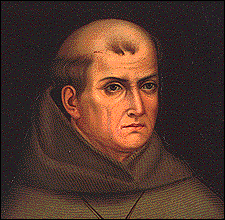 Apostle of California.
Apostle of California.1713-1784 Entered the Franciscan University at Palma, Spain at age 15, and joined the Order at age 17, taking the name Junipero after the friend of Saint Francis. Ordained in 1737, and taught philosophy and theology at the Lullian University. In 1749, Serra was sent to the missionary territories of the west of North America. A mosquito bite he received early in his trip to the New World left one leg swollen; this and his asthma made walking a painful process for the rest of his life. In 1768 he took over missions in the Mexican provinces of Lower and Upper California, missions the Jesuits were forced to abandon by order of King Charles III. A tireless worker, Serra was largely responsible for the foundation and spread of the Church on the West Coast of the United States. Founded twenty-one missions, converted thousands of Native Americans, and trained many of them in European methods of agriculture, cattle husbandry, and crafts. Dedicated religious and missionary, penitent and austere in all areas of his life. St. Junipero Serra is the namesake of the Serra Club, an international Catholic organization dedicated to the promotion of vocations, and the support of seminarians and religious novices. Many of his letters and other writings have survived, and the diary of his travels to the west was published in the early 20th century. Feast Day Prayer.... God most high, your servant Junipero Serra brought the gospel of Christ to the peoples of Mexico and California and firmly established the Church among them. By his intercession, and through the example of his apostolic zeal, inspire us to be faithful witnesses of Jesus Christ, who lives and reigns with you and the Holy Spirit, one God, for ever and ever. Amen. St. Junipero Serra, pray for us! 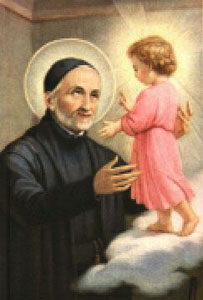 1530-1616
1530-1616Italian. Born to the Italian nobility. Studied law and medicine at Bologna, Italy, receiving a law degree in 1556. Mayor of Felizzano, Italy. Judge. Chief tax collector in Alessandria, Italy. Mayor of Cassine, Italy. Mayor of Castelleone, Italy. Superintendent of the fiefs of the marquis of Naples, Italy. Following a retreat, he became a Jesuit in 1564, and was ordained in 1567. Novice master in Naples, and then was sent to found a college in Lecce, a small city in the south of Italy. He quickly became the most loved man in Lecce due to his concern and charity. He made himself appear the receiver rather than the giver, and the poor and galley slaves were his special concern. One of the more interesting miracles attributed to him concerned his small pitcher of wine which was never empty until everyone present had had enough. On Bernadine's death bed, the city's magistrates formally requested that in the after-life he take the city under his patronage. Unable to speak, he nodded, and died soon after, whispering the names of Jesus and Mary. St. Bernadine Realino, pray for us!  Martyred, c.72
Martyred, c.72Stabbed with a spear while in prayer in India. Apostle. He was ready to die with Jesus when Christ went to Jerusalem, but is best remembered for doubting the Resurrection until allowed to touch Christ's wounds. Preached in Parthia, Persia and India, though he was so reluctant to start the mission that he had to be taken into slavery by a merchant headed that way. He eventually gave in to God's will, was freed, and planted the new Church over a wide area. He formed many parishes and built many churches along the way. An old tradition says that Thomas baptized the wise men from the Nativity into Christianity. O Glorious Saint Thomas, your grief for Jesus was such that it would not let you believe he had risen unless you actually saw him and touched his wounds. But your love for Jesus was equally great and it led you to give up your life for him. Pray for us that we may grieve for our sins which were the cause of Christ's sufferings. Help us to spend ourselves in his service and so earn the title of "blessed" which Jesus applied to those who would believe in him without seeing him. Amen. St. Thomas the Apostle, pray for us! 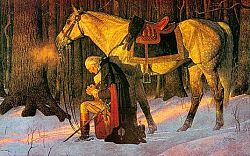 GOD BLESS THE UNITED STATES OF AMERICA!
GOD BLESS THE UNITED STATES OF AMERICA!George Washington's Prayer for the United States of America ALMIGHTY GOD; we make our earnest prayer that Thou wilt keep the United States in Thy holy protection, that thou wilt incline the hearts of the citizens to cultivate a spirit of subordination and obedience to government; and entertain a brotherly affection and love for one another and for their fellow citizens of the United States of America at large. And finally that Thou wilt most graciously be pleased to dispose us all to do justice, to love mercy and to demean ourselves with that charity, humility and pacific temper of mind which were the characteristics of The Divine Author of our blessed religion, and without whose example in these things we can never hope to be a happy nation. Grant our supplication, we beseech thee, through Jesus Christ Our Lord. Amen -George Washington, April 30, 1789 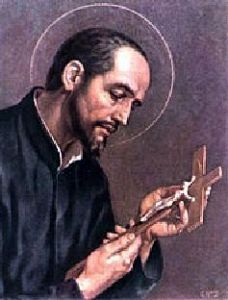 Italian. 1502-1539
Italian. 1502-1539St. Anthony Mary Zaccaria was born in Cremona, Italy, in 1502. His father died while Anthony was an infant, leaving his education and upbringing to his young mother, a widow at 18. By age 22, Anthony completed his studies in Padua earning a medical doctorate. However, the medical practice was not to be his calling. He was instead called to heal souls. Anthony received Holy Orders in 1528, and worked with the poor and the sick. He was also a spiritual director and reformer. As a contemporary of Martin Luther, his reformations instead focused to build up the Body of Christ rather than to cause division and strife. One means to reform was his founding of the Clerks Regular of St. Paul, commonly known as the Barnabites. This Religious Order was the first named after Paul the Apostle. Through his order, St. Anthony promoted a reformation program involving the combined strengths and experiences of Priests -- The Clerics Regular of St. Paul, Uncloistered nuns -- The Angelics of St. Paul, and Married people -- The Marrieds of St. Paul (laity). Though the Laity of St. Paul diminished after St. Anthony's death, the order experienced resurgence in the 1990s. "That which God commands seems difficult and a burden. The way is rough; you draw back; you have no desire to follow it. Yet do so and you will attain glory." - St. Anthony Mary Zaccharia St. Antonio Maria Zaccaria, pray for us! 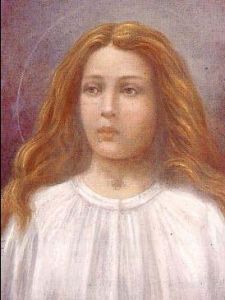 The daughter of a share cropper, Maria Goretti and her family moved to the little town of Ferriere, Italy in 1899 in search of work. Desperately seeking to support his family, Luigi Goretti struck up a bargain with Signor Serenelli, who had a son name Alessandro. The two families lived together in a building owned by Count Mazzolini.
The daughter of a share cropper, Maria Goretti and her family moved to the little town of Ferriere, Italy in 1899 in search of work. Desperately seeking to support his family, Luigi Goretti struck up a bargain with Signor Serenelli, who had a son name Alessandro. The two families lived together in a building owned by Count Mazzolini.Maria quickly matured in grace and holiness in the eyes of friends and other acquaintances. After losing her father to malaria, she developed great strength and maturity. Her charming modesty, cheerful obedience and the serious, but free acceptance of a hundred thankless home chores distinguished her from the other children who would play in the dusty streets of Ferriere. Lured by the passions of his day and nurturing the dark side of his soul, Alessandro Serenelli had been a thorn in lovely Maria's side. He propositioned her on several occasions and harassed her. On July 5, 1902, he would be denied no longer. As she once again rebuffed his sexual advance, shouting, "No! It is a sin! God does not want it!". Alessandro stabbed Maria 14 times. After 20 hours of suffering during which she forgave and prayed for Alessandro, Maria entered into eternal life. Her last earthly gaze rested upon a picture of the Blessed Mother. It was July 6, 1902. Maria Goretti's heroic story of love and forgiveness would not be complete without one of its first miraculous fruits...the conversion of Alessandro Serenelli, Maria's murderer. Immediately after his brutal assault on young Maria Goretti, Alessandro was imprisoned temporarily in Nettuno and then transferred to Regina Coeli prison in Rome to stand trial. After vehemently denying his guilt, he finally broke down in the face of overwhelming testimony. Since he was a minor, he was sentenced to only thirty years hard labor. In the days following, Alessandro lost his appetite and grew nervous. After 6 years of prison, he was on the brink of despair. Then one night, Maria appeared to him in his cell. She smiled at Alessandro and was surrounded by lilies, the flower symbolic of purity. From that moment peace invaded his heart, and he began living a constructive life. After serving his sentence, he took up residence at a Capuchin monastery, working as a gardener. He asked pardon of Maria's mother and accompanied her to Christmas Mass in the parish church where he spoke before a hushed congregation, acknowledging his sin and asking God's forgiveness and the pardon of the community. Forty years later, on June 24, 1950, Maria was canonized at St. Peter's Basilica in Rome in the presence of Maria's mother, Assunta, and murderer, Alessandro Serenelli. The painting seen here of Maria Goretti was painted by a nun and it was said by Maria's mother, to be the best likeness of her daughter. It now hangs in the hospital room in which Maria died, now a chapel, in the city of Nettuno, Italy.  1902-1977
1902-1977Blessed Maria Romero Meneses is a saint of the new millennium. She was beatified by Pope John Paul II in 2002. Maria was born in Granada, Nicaragua, in 1902 to a wealthy family, her father being a government minister. At the age of 12, she became extremely sick and was paralyzed for six months with rheumatic fever. She was cured through the intercession and apparition of Our Lady Help of Christians, during which she discovered her vocation to be a Salesian sister. She entered the Daughters of Mary Help of Christians (Salesian Sisters) and made her final profession in 1929. Two years later, she was transferred to San Jose, Costa Rica. She taught music, drawing and typing to rich girls. She also trained catechists and taught the poor. She inspired many of her students to join her in her work with the poor, and was known for helping people to come to know God in a personal way. More and more, her ministry became focused on social development, helping the rich to see how they could help the poor. She set up recreational centers in 1945, food distribution centers in1953, a school for poor girls in 1961, and a clinic in 1966. In 1973, she organized the construction of seven homes, which became the foundation of the village of Centro San Jose, a community where poor families could have decent homes. She died of a heart attack in 1977 in Nicaragua. Prayer to Mary, Help of Christians..... Most Holy Virgin Mary, Help of Christians, how sweet it is to come to your feet imploring your perpetual help. If earthly mothers cease not to remember their children, how can you, the most loving of all mothers forget me? Grant then to me, I implore you, your perpetual help in all my necessities, in every sorrow, and especially in all my temptations. I ask for your unceasing help for all who are now suffering. Help the weak, cure the sick, convert sinners. Grant through your intercessions many vocations to the religious life. Obtain for us, O Mary, Help of Christians, that having invoked you on earth we may love and eternally thank you in heaven. - Prayer by St. John Bosco  Died, 689.
Died, 689.One day Killian made up his mind to be a missionary, left his native country of Ireland with eleven companions, and set out for Europe. They traveled through Gaul, arrived at Aschaffenburg on the Rhein and then sailed up to the River Main and Wurzburg. The castle of Würzburg was at that time inhabited by the Frankish Duke Gosbert (Gospert, Gozbert), who was, like his people, still pagan. Kilian resolved to preach the Gospel here, but first journeyed with his companions to receive guidance from the pope. Kilian and his companions arrived in Rome in the autumn of 686, expecting to receive his missionary faculties from Pope John V, but John V had died and had been succeeded by Pope Conon. Fortunately the trip was not in vain: Kilian and his companions were granted permission from Conon to pursue their evangelistic mission. On the return from Rome, the original group separated. St. Kilian came back to Würzburg with two companions, the priest Colman (Coloman, Colonat) and the deacon Totnan. The other nine travellers carried out their missionary work in other areas. Kilian took Wurzburg as the base of his activity, which also extended over an ever-increasing area in East Franconia and Thuringia. He converted Duke Gosbert to Christianity, along with a large number of his subjects. The account of the baptism of Gosbert in a large wooden tub has been recorded by ancient sources. St. Killian Prayer.... God, you called missionaries from Ireland with Saint Killian to take the message of the gospel to Franconia and Bavaria; Grant that the church may draw strength from their examples, and never lack zeal to proclaim your love when the going is difficult: through Jesus Christ our Lord. Amen. 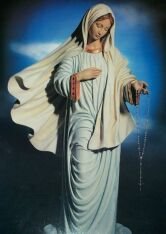 Our dearest Mother Mary,
Our dearest Mother Mary,Our Lady of Peace We ask that you intercede for all of us As we work for peace at home and everywhere else. Guide us with your loving embrace Each day we walk this earth That with the warmth of your love We will feel safe and secure. We love you Mother, Our Lady of Peace! Amen!  c. 150
c. 150Sons of St. Felicitas - Januarius, Felix, Philip, Silvanus, Alexander, Vitalis, & Martialis Grant, we beseech Thee, almighty God, that we who acknowledge the steadfastness of Thy glorious Martyrs in confessing Thy Name, may feel their loving intercession for us with Thee. Amen. 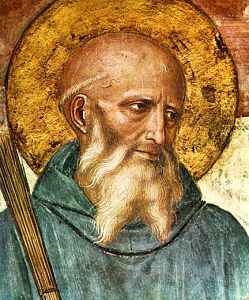 Monk & Founder of the Benedictines
Monk & Founder of the BenedictinesDied: 547, Monte Cassino, Italy Benedict was born into a distinguished family in central Italy, studied at Rome and early in life was drawn to the monastic life. At first he became a hermit, leaving a depressing world--pagan armies on the march, the Church torn by schism, people suffering from war, morality at a low ebb. He soon realized that he could not live a hidden life in a small town any better than in a large city, so he withdrew to a cave high in the mountains for three years. Some monks chose him as their leader for a while, but found his strictness not to their taste. Still, the shift from hermit to community life had begun for him. He had an idea of gathering various families of monks into one "Grand Monastery" to give them the benefit of unity, fraternity, permanent worship in one house. Finally he began to build what was to become one of the most famous monasteries in the world--Monte Cassino, commanding three narrow valleys running toward the mountains north of Naples. The Rule that gradually developed prescribed a life of liturgical prayer, study, manual labor and living together in community under a common father (abbot). Benedictine asceticism is known for its moderation, and Benedictine charity has always shown concern for the people in the surrounding countryside. In the course of the Middle Ages, all monasticism in the West was gradually brought under the Rule of St. Benedict. Today the Benedictine family is represented by two branches: the Benedictine Federation and the Cistercians Prayer ought to be short and pure, unless it be prolonged by the inspiration of Divine grace. - St. Benedict St. Benedict's Prayer for the Gifts to Seek God and Live in Him...... Father, in your goodness grant me the intellect to comprehend you, the perception to discern you, and the reason to appreciate you. In your kindness endow me with the diligence to look for you, the wisdom to discover you, and the spirit to apprehend you. In your graciousness bestow on me a heart to contemplate you, ears to hear you, eyes to see you, and a tongue to speak of you. In your mercy confer on me a conversation pleasing to you, the patience to wait for you, and the perseverance to long for you. Grant me a perfect end - your holy presence. Amen. 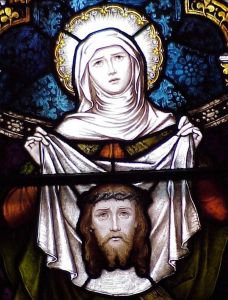 Saint Veronica, was a pious woman of Jerusalem who, moved with pity as Jesus carried his cross to Golgotha, gave him her veil that he might wipe his forehead. Jesus accepted the offering and after using it handed it back to her, the image of his face miraculously impressed upon it.
Saint Veronica, was a pious woman of Jerusalem who, moved with pity as Jesus carried his cross to Golgotha, gave him her veil that he might wipe his forehead. Jesus accepted the offering and after using it handed it back to her, the image of his face miraculously impressed upon it.St. Veronica, you gave Christ a towel on His way to Cavalry which He used to wipe the Precious Blood from His Holy Face. In return for this great act of kindness He left you His most Holy image on the towel. Pray for us to Our Lord that His Holy Face may be imprinted on our hearts so that we may be always be mindful of the Passion and Death of Our Lord Jesus Christ, through the same Christ our Lord, Amen. St. Veronica, pray for us!  Italian. 1847-1870
Italian. 1847-1870From her earliest life, she paid no attention to this world, focused solely on the spiritual life. Founded the Congregation of Minims of the Sorrowful Mother who concentrate on ministering in hospitals and elementary schools to the sick, the aged, the lonely, and a prayer ministry for the poor. Since her death, her voice has been heard in the houses of her order, accompanying her sisters in song. "Oh, great Lord God, You see that my will is to love You, and to try to avoid offending You. Oh Lord, open Your Heart and send forth the flames of love. Enkindle my heart with these flames and burn me with love" -St. Clelia Barbieri - 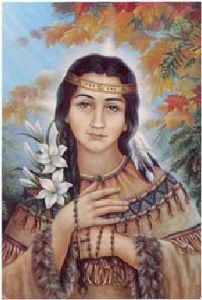 1656-1680
1656-1680Kateri was born near the town of Auriesville, New York, in the year 1656, the daughter of a Mohawk warrior. She was four years old when her mother died of smallpox. The disease also attacked Kateri and transfigured her face. She was adopted by her two aunts and an uncle. Kateri became converted as a teenager. She was baptized at the age of twenty and incurred the great hostility of her tribe. Although she had to suffer greatly for her Faith, she remained firm in it. Kateri went to the new Christian colony of Indians in Canada. Here she lived a life dedicated to prayer, penitential practices, and care for the sick and aged. Every morning, even in bitterest winter, she stood before the chapel door until it opened at four and remained there until after the last Mass. She was devoted to the Eucharist and to Jesus Crucified. She died on April 17, 1680 at the age of twenty-four. She is known as the "Lily of the Mohawks". Devotion to Kateri is responsible for establishing Native American ministries in Catholic Churches all over the United States and Canada. Kateri was declared venerable by the Catholic Church in 1943 and she was Beatified in 1980. Kateri was canonized on October 21, 2012. Hundreds of thousands have visited shrines to Kateri erected at both St. Francis Xavier and Caughnawaga and at her birth place at Auriesville, New York. Pilgrimages at these sites continue today. St. Kateri Tekakwitha is the first Native American to be declared a Saint. She is the patroness of the environment and ecology as is St. Francis of Assisi. Prayer.... Loving Creator God, we acknowledge your power and presence in the Four Directions of your vast and beautiful universe. We celebrate Kateri Tekakwitha, "Lily of the Mohawks", as one of your Son's most faithful followers. Help us to turn our backs on all evil and walk in her footsteps, sharing our love and Christian concern with others. Let us reverence, as she did, your mystical presence in the poor and suffering. Through Kateri's powerful intercession, we confidently ask you to grant us this special favor we ask for in her name. (Mention your intentions.) Share your healing and peace especially with my family, friends and the sick, whom we commend to your loving care. We ask this through your crucified and risen Son, our Lord Jesus Christ, the eternal World, who lives and reigns with you forever and ever. Amen. Prayer from the National Shrine in Fonda (Caughnawaga) NY St. Kateri Tekakwitha, pray for us. 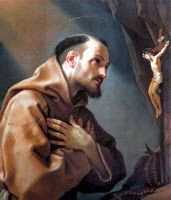 Italian. 1221-1274
Italian. 1221-1274Bonaventure, Franciscan, theologian, doctor of the Church, was both learned and holy. Because of the spirit that filled him and his writings, he was at first called the Devout Doctor; but in more recent centuries he has been known as the Seraphic Doctor after the "Seraphic Father" Francis because of the truly Franciscan spirit he possessed. Born in Bagnoregio, a town in central Italy, he was cured of a serious illness as a boy through the prayers of Francis of Assisi. Later, he studied the liberal arts in Paris. Inspired by Francis and the example of the friars, especially of his master in theology, Alexander of Hales, he entered the Franciscan Order, and became in turn a teacher of theology in the university. Chosen as minister general of the Order in 1257, he was God's instrument in bringing it back to a deeper love of the way of St. Francis, both through the life of Francis which he wrote at the behest of the brothers and through other works which defended the Order or explained its ideals and way of life. "When we pray, the voice of the heart must be heard more than that proceeding from the mouth." - St. Bonaventure of Bagnoregio 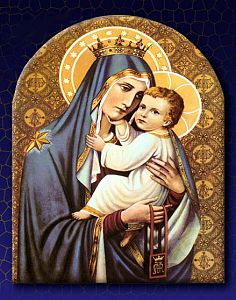 Feast of Our Lady of Carmel - July 16
Feast of Our Lady of Carmel - July 16This prayer to Our Lady of Mount Carmel derives from an antiphon, 'Flos Carmeli' ('The Flower of Carmel'), composed by St. Simon Stock (c. 1165-1265). St. Simon Stock is said to have received the Scapular of Our Lady of Mount Carmel (commonly called 'the Brown Scapular') from the Blessed Virgin Mary herself, when she appeared to him on July 16, 1251 (now the Feast of Our Lady of Mount Carmel). This prayer, therefore, is often tied to the Brown Scapular and is also recited as a novena before the Feast of Our Lady of Mount Carmel. It can, however, be recited at any time for any need. (For a longer prayer to Our Lady of Mount Carmel that can also be recited in a group, see the Litany of Intercession to Our Lady of Mount Carmel.) Prayer to Our Lady of Mount Carmel O most beautiful Flower of Mount Carmel, fruitful vine, splendor of Heaven, Blessed Mother of the Son of God, Immaculate Virgin, assist me in this my necessity. O Star of the Sea, help me and show me herein that you are my Mother. O Holy Mary, Mother of God, Queen of Heaven and earth, I humbly beseech you from the bottom of my heart, to succor me in this my necessity. There are none that can withstand your power. O show me herein that you are my Mother. O Mary, conceived without sin, pray for us that have recourse to thee. (3 times) Sweet Mother, I place this cause in your hands. (3 times) 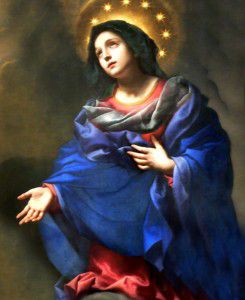 May we, O Lord, be cleansed of every stain of our sins: and by the intercession of the glorious and blessed Mary ever-Virgin, may we be led to the kingdom of heaven by the way of humility. Amen.
May we, O Lord, be cleansed of every stain of our sins: and by the intercession of the glorious and blessed Mary ever-Virgin, may we be led to the kingdom of heaven by the way of humility. Amen."O Mary, conceived without sin, pray for us who have recourse to thee." "The most powerful weapon to conquer the devil is humility. For, as he does not know at all how to employ it, neither does he know how to defend himself from it." - St. Vincent de Paul 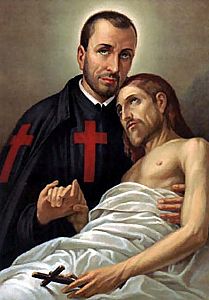 St. Camillus de Lellis was born at Bocchianico, Italy. He fought for the Venetians against the Turks, was addicted to gambling, and by 1574 was penniless in Naples. He accepted work at the Capuchin friary at Manfredonia, and was one day so moved by a sermon of the superior that he began a conversion that changed his life.
St. Camillus de Lellis was born at Bocchianico, Italy. He fought for the Venetians against the Turks, was addicted to gambling, and by 1574 was penniless in Naples. He accepted work at the Capuchin friary at Manfredonia, and was one day so moved by a sermon of the superior that he began a conversion that changed his life.He became a Capuchin novice, but was unable to be professed because of a diseased leg he contracted while fighting the Turks. He devoted himself to caring for the sick, and became director of St. Giacomo Hospital in Rome. He received permission from his confessor (St. Philip Neri) to be ordained and decided, with two companions, to found his own congregation, the Ministers of the Sick (the Camillians), dedicated to the care of the sick. They ministered to the sick of Holy Ghost Hospital in Rome, enlarged their facilities in 1585, founded a new house in Naples in 1588, and attended the plague-stricken aboard ships in Rome's harbor and in Rome. In 1591, the Congregation was made into an order to serve the sick by Pope Gregory XIV, and in 1591 and 1605, Camillus sent members of his order to minister to wounded troops in Hungary and Croatia, the first field medical unit. Gravely ill for many years, he resigned as superior of the Order in 1607 and died in Rome on July 14, the year after he attended a General Chapter there. He was canonized in 1746, was declared patron of the sick, with St. John of God, by Pope Leo XIII, and patron of nurses and nursing groups by Pope Pius XI. His feast day is July 18th. Quote: "Think well. Speak well. Do well. These three things, through the mercy of God, will make a man go to Heaven." ~Saint Camillus de Lellis Prayer to Saint Camillus de Lellis.... Most wonderful Saint, your compassion for the sick and the dying led you to found the Servants of the Sick. As the Patron of nurses and hospital workers, infuse in them your compassionate spirit. Make hospitals resemble the inn in Christ's Parable to which the Good Samaritan brought the wounded man saying: "Take care of him and I will repay you for it." Amen. St. Camillus de Lellis, pray for us!  1637-1679
1637-1679One of the Forty Martyrs of England and Wales. He was born at Dimples, Lancashire, England, the son of a Royalist Catholic. Educated at Valladolid, Spain, and St. Omer's in France. He was ordained in Segovia in 1662. John returned to England after ordination and served as a missionary in Cheshire. He became a tutor at Puddington Hall near Chester until his arrest and martyrdom by hanging at Barrowshill, Boughton. near Chester. Pope Paul VI canonized him in 1970. Oh God, in whom there is no change or shadow of alteration, you gave courage to the English Martyr, John Plessington. Grant unto us, we beseech you, through his intercession, the grace to always value the Holy Mass. May we be strengthened to serve you in imitation of the courageous heart of John Plessington and all the English Martyrs. We ask this through Jesus Christ, Your Son, who lives and reigns with You in the unity of the Holy Spirit, forever. Amen. St. John Plessington, pray for us! 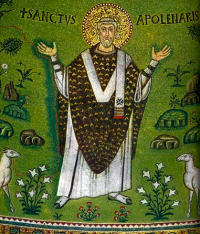 Tradition tells us that St. Apollinaris, who lived in the first and second centuries, was born in what was then Antioch in today's country of Turkey. He was made Bishop of Ravenna in Italy by St. Peter himself and was known as a great preacher and evangelizer of people. But like many Christians of his era, his faith made him the target of persecution. He was beaten, tortured and driven from Ravenna several times, but kept returning, often in secret, to continue spreading the Good News of Jesus. He was said to have worked many miracles and today his name is invoked against the condition of epilepsy. Artwork often depicts him performing miraculous acts. He is buried in the Basilica of St. Apollinaris in Ravenna.
Tradition tells us that St. Apollinaris, who lived in the first and second centuries, was born in what was then Antioch in today's country of Turkey. He was made Bishop of Ravenna in Italy by St. Peter himself and was known as a great preacher and evangelizer of people. But like many Christians of his era, his faith made him the target of persecution. He was beaten, tortured and driven from Ravenna several times, but kept returning, often in secret, to continue spreading the Good News of Jesus. He was said to have worked many miracles and today his name is invoked against the condition of epilepsy. Artwork often depicts him performing miraculous acts. He is buried in the Basilica of St. Apollinaris in Ravenna.Prayer...... God of power and mercy, you gave Apollinaris, your martyr, victory over pain and suffering. Strengthen us who celebrate this day of his triumph and help us to be victorious over the evils that threaten us. Grant this through our Lord Jesus Christ, your Son, who lives and reigns with you and the Holy Spirit, one God, forever and ever. Amen. St. Apollinaris, pray for us!  Italian. 1559-1619
Italian. 1559-1619Son of Guglielmo de Rossi and Elisabetta Masella. He felt an early call to religious life, and was educated by the Friars Minor Conventuals of Brindisi, Italy. His father died when the boy was twelve. Studied in Venice. Joined the Capuchin Friars in 1575 at age 16, taking the name Brother Lorenzo. Studied theology, the Bible, French, German, Greek, Spanish, Syriac, and Hebrew at the University of Padua; he was a brilliant student, known for his facility with languages. Priest. Taught theology. Served as linguist and military chaplain. Famous, effective and forceful preacher in any of his several languages. Founded convents of Vienna and Graz in Austria, and in Prague, Czech Republic. Wrote catechisms. Chaplain of the army of the Holy Roman Empire in 1601. Rallied the German princes to fight a superior Turkish force, and was asked to lead the army into battle at Stuhlweissenburg (modern Hungary) carrying no weapon but a crucifix; the Turks were completely defeated. Master general of his order from 1602 to 1605; he was the choice for another term, but turned it down. Carried out important and successful diplomatic peace missions to Munich, Germany and Madrid, Spain. Assigned in 1605 to evangelize in Germany, where he had great success. Convinced Philip III of Spain to join the German Catholic League. Commissary general of his order for the provinces of Tyrol and Bavaria in Germany. Spiritual director of the Bavarian army. Tended to fall into ecstasies when celebrating Mass. In 1956, the Capuchin Order compiled fifteen volumes of his sermons, letters and writings. Proclaimed Apostolic Doctor of the Church by Pope John XXIII in 1959. "God is love, and all his operations proceed from love. Once he wills to manifest that goodness by sharing his love outside himself, then the Incarnation becomes the supreme manifestation of his goodness and love and glory. So, Christ was intended before all other creatures and for his own sake. For him all things were created and to him all things must be subject, and God loves all creatures in and because of Christ. Christ is the first-born of every creature, and the whole of humanity as well as the created world finds its foundation and meaning in him. Moreover, this would have been the case even if Adam had not sinned." - St. Lawrence of Brindisi St. Lawrence of Brindisi, pray for us!  We have very little solid information about St. Mary, and both scholars and traditions differ on the interpretation of what we do know. From the New Testament, one can conclude that Mary was from the village of Magdala (on the shore of the Sea of Galilee). She was a friend and follower of Jesus. Filled with sorrow over her sin, she anointed Christ, washed his feet with her hair. He exorcised seven demons from her. She was visited by the Risen Christ.
We have very little solid information about St. Mary, and both scholars and traditions differ on the interpretation of what we do know. From the New Testament, one can conclude that Mary was from the village of Magdala (on the shore of the Sea of Galilee). She was a friend and follower of Jesus. Filled with sorrow over her sin, she anointed Christ, washed his feet with her hair. He exorcised seven demons from her. She was visited by the Risen Christ.Prayer...... Saint Mary Magdalene, woman of many sins, who by conversion became the beloved of Jesus, thank you for your witness that Jesus forgives through the miracle of love. You, who already possess eternal happiness in His glorious presence, please intercede for me, so that some day I may share in the same everlasting joy. Amen. 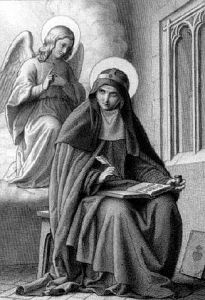 1303-1373
1303-1373Born in Sweden. Died in Rome. Buried in Sweden. Daughter of Birger Persson, the governor and provincial judge of Uppland, and of Ingeborg Bengtsdotter. Her father was one of the greatest landowners in the country, her mother was known widely for her piety, and the family were descendants of the Swedish royal house. Related to Saint Ingrid of Sweden. Bridget began receiving visions, most of the Crucifixion, at age seven. Her mother died c.1315 when the girl was about twelve years old, and she was raised and educated by an equally pious aunt. In 1316, at age thirteen, Bridget wed prince Ulfo of Nercia in an arranged marriage. She was the mother of eight, including Saint Catherine of Sweden; some of the other children ignored the Church. Friend and counselor to many priests and theologians of her day. Chief lady-in-waiting to Queen Blanche of Namur in 1335, from which position she counseled and guided the Queen and King Magnus II. After Ulfo's death in 1344 following a pilgrimage to Santiago de Compostela, Spain she pursued a religious life, for which she was harassed by others at the court. She eventually renounced her title of princess. Franciscan tertiary. Cistercian. Mystic, visionary, and mystical writer. She recorded the revelations given her in her visions, and these became hugely popular in the Middle Ages. Founded the Order of the Most Holy Savior (Bridgettines) at Vadstena, Sweden in 1346. It received confirmation by Pope Blessed Urban V in 1370, and survives today, though few houses remain. Pilgrim to Rome, to assorted Italian holy sites, and to the Holy Lands. Chastened and counseled kings and Popes Clement VI, Gregory XI, and Urban VI, urging each to return to Rome from Avignon. Encouraged all who would listen to meditate on the Passion, and of Jesus Crucified. O Lord, make haste and illumine the night. I long for You as the dying long for You. Say to my soul that nothing happens without Your permitting it, and that nothing of what You permit is without comfort. O Jesus, Son of God, You who were silent in the presence of Your accusers restrain my tongue until I find what I should say and how to say it. Show me the way and make me ready to follow it. It is dangerous to delay, yet perilous to go forward. Answer my petition and show me the way. I come to You as the wounded go to the doctor in search of aid. Give peace O Lord to my heart! Amen. - St. Bridget of Sweden St. Bridget of Sweden, pray for us!  1880-1936
1880-1936Martyr. Beatified by Pope John Paul II in 1990. Baptized on 7 March 1880, and made her First Holy Communion on 30 June 1890. Pious child who attended Mass nearly every day. Devoted student, a painter, and excelled in needlework. Joined the Society of Saint Teresa of Jesus in 1904 in Tortosa. Assigned to the motherhouse in Barcelona in 1920. On 19 July 1936 her community was forced by anti-Catholic government authorities to abandon their house and school. Mercedes was arrested and shot on 23 July 1936 for the crime of being a nun. Prayer... God, Father of infinite goodness, you gave Blessed Maria Mercedes Prat, the courage to bring to fullness in martyrdom her offering to you and to the Church. Grant us, through her intercession, the grace to be so firmly rooted in the love of Christ that nothing can ever separate us from this love. Grant this through our Lord Jesus Christ, your Son, Who lives and reigns with you and the Holy Spirit, One God, for ever and ever. Amen. 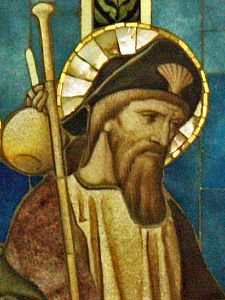 Son of Zebedee and Salome, brother of Saint John the Apostle, and may have been Jesus' cousin. He is called "the Greater" simply because he became an Apostle before Saint James the Lesser. Apparent disciple of Saint John the Baptist. Fisherman. He left everything when Christ called him to be a fisher of men. Was present during most of the recorded miracles of Christ. Preached in Samaria, Judea, and Spain. First Apostle to be martyred.
Son of Zebedee and Salome, brother of Saint John the Apostle, and may have been Jesus' cousin. He is called "the Greater" simply because he became an Apostle before Saint James the Lesser. Apparent disciple of Saint John the Baptist. Fisherman. He left everything when Christ called him to be a fisher of men. Was present during most of the recorded miracles of Christ. Preached in Samaria, Judea, and Spain. First Apostle to be martyred.The pilgrimage to his relics in Compostella became such a popular devotion that the symbols of pilgrims have become his emblems, and he became patron of pilgrims. His work in Spain, and the housing of his relics there, led to his patronage of the country and all things Spanish; for centuries, the Spanish army rode to battle with the cry "Santiago!" ("Saint James!") Prayer... O Glorious Saint James, because of your fervor and generosity Jesus chose you to witness his glory on the Mount and his agony in the Garden. Obtain for us strength and consolation in the unending struggles of this life. Help us to follow Christ constantly and generously, to be victors over all our difficulties, and to receive the crown of glory in heaven. Amen. 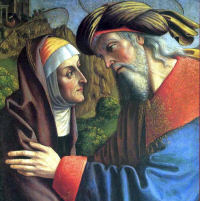 It was in the home of Joachim and Ann where the Virgin Mary received her training to be the Mother of God. Thus, devotion to Ann and Joachim is an extension of the affection Christians have always professed toward our Blessed Mother. We, too, owe a debt of gratitude to our parents for their help in our Christian formation.
It was in the home of Joachim and Ann where the Virgin Mary received her training to be the Mother of God. Thus, devotion to Ann and Joachim is an extension of the affection Christians have always professed toward our Blessed Mother. We, too, owe a debt of gratitude to our parents for their help in our Christian formation.PRAYER TO SAINT ANN & SAINT JOACHIM Grandparents' Prayer... Good Saint Ann and Saint Joachim, parents of Mary and grandparents to Jesus, be with me and all grandparents that we may be wise and loving, may share our time and stories and sense of humor, and may enjoy and not spoil too much the grandchildren who are close to our hearts, for they are the sign of God's life to us. Jesus, Mary and Joseph, be with our grandchildren and all other grandchildren that they may love and respect their grandparents and all older people, may remember to call, visit or write, and grow in wisdom, age and grace before God. Amen. 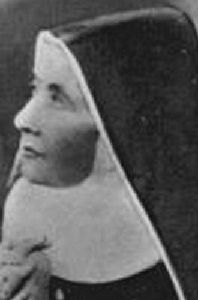 Italian. 1866-1912
Italian. 1866-1912(also known as Blessed Maria of the Passion of Our Lord Jesus Christ) Born to Leopoldo Tarallo and Concetta Borriello, Maria was raised in a pious family, and received a Christian education. She made a private vow of virginity at age five in front of a statue of the Blessed Mother. Made her First Communion at age 7, and received Confirmation at 10. Feeling drawn to religious life, at 22 she wanted to enter a convent, but her family opposed it, hoping she would marry; however, the young man who had proposed to her died before the wedding. Entered the monastery of the Sisters Crucified Adorers of the Eucharist in Barra on 1 June 1891, taking the name Sister Maria of the Passion. Student of the Servant of God Maria Pia Notari. Served as novice mistress and as spiritual guide to her sisters, worked in the kitchen and laundry, and as porter. Known for her life of charity, deep prayer, and devotion to her Congregation and the Eucharist. Quotes by Blessed Maria.... "My name is Sr. Maria of the Passion and I must resemble the Master". "I want to be holy, loving Jesus in the Eucharist, suffering with Christ Crucified and seeing Christ in my brothers and sisters." "I exhort you to holy perseverance according to the Rule, readiness in obedience and especially daily Adoration of Jesus in the Blessed Sacrament. Love Jesus in the Eucharist, never leave him alone, do not anger him, do not disappoint him." - Blessed Maria to her Sisters 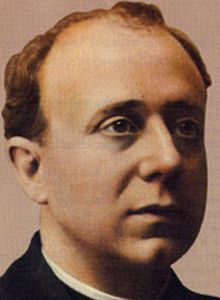 Spanish Martyr.
Spanish Martyr.1874-1936 Raised in a pious family, he felt an early call to the priesthood. He entered the seminary in Jaen in 1889, then the seminary of Guadix, Grenada. Ordained on 17 April 1897. He taught at the seminary, continued his studies, and received his licentiate in theology in Seville in 1900. He ministered in Guadix to a group of people so poor they lived in caves. He built a school for the children, and provided vocation training to the adults. He was transferred to Madrid, and was named a canon of the Basilica of Covadonga, Asturius in 1906. His time in Guadix had impressed Pedro with the need for education for the poor. He prayed on the topic, and wrote on the need for professional training for teachers. In 1911 Pedro founded the Saint Teresa of Avila Academy, the foundation of Institución Teresiana. He joined the Apostolic Union of Secular Priests in 1912, wrote on the need for more teachers, and opened teacher training centers. He returned to teaching at the seminary at Jaen, served as spiritual director of Los Operarios Catechetical Centre, and taught religion at the Teachers Training School. In 1914 he opened Spain's first university residence for women in Madrid. In 1921 he was transferred to Madrid and was appointed a chaplain of the Royal Palace. In 1922 he was appointed to the Central Board Against Illiteracy, and he continued to work with the Teresian Association; it received papal approval in 1924, and later spread to Chile and Italy. Martyred in the Spanish Revolution. "Lord, that I may think what you want me to think; that I may wish what you want me to wish; that I may speak what you want me to speak; that I may act as you want me to act. This is my only aspiration" (1933, personal notes of St. Pedro Poveda Castroverde) 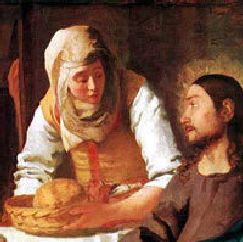 Sister of Saint Lazarus and Saint Mary of Bethany. Friend of Jesus, and hostess to him in her house.
Sister of Saint Lazarus and Saint Mary of Bethany. Friend of Jesus, and hostess to him in her house.- from a sermon by Saint Augustine....... "Martha and Mary were sisters, related not only by blood but also by religious aspirations. They stayed close to our Lord and both served him harmoniously when he was among them. Martha welcomed him as travelers are welcomed. But in her case, the maidservant received her Lord, the creature her Creator, to serve him bodily food while she was to be fed by the Spirit. No one of you should say, "Blessed are they who have deserved to receive Christ into their homes!" Do not grieve or complain that you were born in a time when you can no longer see God in the flesh. He did not in fact take this privilege from you. As he says, "Whatever you have done to the least of my brothers, you did to me." O blessed St. Martha, your faith led Jesus to proclaim, "I am the resurrection and the life"; and faith let you see beyond his humanity when you cried out, "Lord I believe that you are the Messiah, the Son of God." With firm hope you said, "I know that God will give you whatever you ask of him", and Jesus called your brother Lazarus back from the dead. With pure love for Jesus you welcomed him into your home. Friend and servant of our Savior, I too am "troubled about many things". (mention your intentions) Pray for me that I may grow in faith, hope and love, and that Jesus, who sat at your table, will hear me and grant me a place at the banquet of eternal life. Amen. 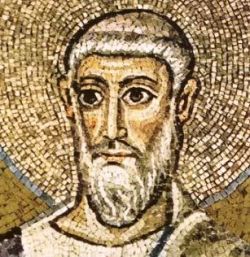 406-450
406-450Adult convert to Christianity. Deacon. Priest. Bishop of Ravenna, Italy in 433. Fought paganism and the Monophysite heresy, enforced reforms, and built several churches and ornate altars in his see. Preacher with such language skills, he was given given the name Chrysologus, referring to his golden word. 176 of his sermons have survived; it is the strength of these beautiful explanations of the Incarnation, the Creed, the place of Mary and John the Baptist in the great plan of salvation, etc., that led to his being proclaimed a Doctor of the Church in 1729 by Pope Benedict XIII. "Prayer, mercy and fasting: These three are one, and they give life to each other. Fasting is the soul of prayer; mercy is the lifeblood of fasting. Let no one try to separate them; they cannot be separated. If you have only one of them or not all together, you have nothing. So if you pray, fast; if fast, show mercy; if you want your petition to be heard, hear the petition of others. When you fast, see the fasting of others. If you hope for mercy, show mercy. If you look for kindness, show kindness. If you want to receive, give." -St. Peter Chrysologus "Anyone who wishes to frolic with the devil cannot rejoice with Christ." - St. Peter Chrysologus 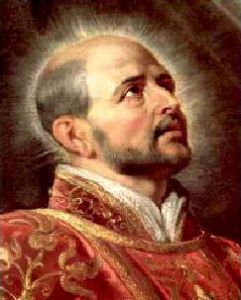 Born in Spain, 1491.
Born in Spain, 1491.Died in Rome, Italy, 1556. Born to the Spanish nobility. Youngest of twelve children. Page in the Spanish court of Ferdinand and Isabella. Military education. Soldier, entering the army in 1517, and serving in several campaigns. Wounded in the leg by a cannonball at the siege of Pampeluna on 20 May 1521, an injury that left him partially crippled for life. During his recuperation the only books he had access to were The Golden Legend, a collection of biographies of the saints, and the Life of Christ by Ludolph the Carthusian. These books, and the time spent in contemplation, changed him. On his recovery he took a vow of chastity, hung his sword before the altar of the Virgin of Montserrat, and donned a pilgrim's robes. He lived in a cave from 1522 to 1523, contemplating the way to live a Christian life. Pilgrim to Rome and the Holy Land in 1523, where he worked to convert Muslims. In 1528 he began studying theology in Barcelona and Alcala in Spain, and Paris, France receiving his degree on 14 March 1534. His meditations, prayers, visions and insights led to forming the Constitutions of the Society of Jesus on 15 August 1534; it received papal approval in 1541. Friend of James Lainez, Alonso Salmerón, Nicholas Bobadilla, Simón Rodriguez, Blessed Peter Faber, and Saint Francis Xavier, the group that formed the core of the new Society. He never used the term Jesuit, which was coined as an insult by his opponents; the Society today uses the term with pride. He traveled Europe and the Holy Lands, then settled in Rome to direct the Jesuits. His health suffered in later years, and he was nearly blind at death. Prayer for Generosity- Lord, teach me to be generous. Teach me to serve you as you deserve; to give and not to count the cost, to fight and not to heed the wounds, to toil and not to seek for rest, to labor and not to ask for reward, save that of knowing that I do your will. -Ignatius of Loyola |




